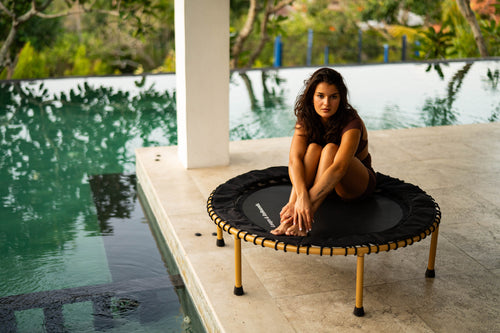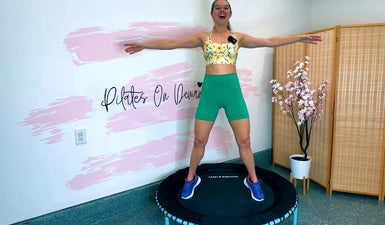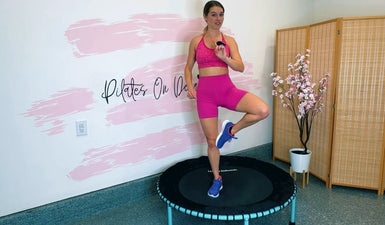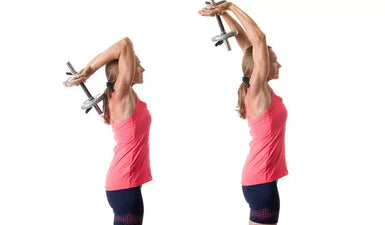So, you want to get better glutes? It's not just about how they look, though that's a big part of it for many people. Strong glutes are actually super important for everything you do – from running and jumping to just standing up straight and not hurting your back. A lot of folks think doing tons of squats is the only way, but there's more to it. We're going to look at some of the best exercise glutes options out there to really get them working and growing.
Key Takeaways
- Focusing on specific glute exercises can lead to better muscle growth and strength.
- Strong glutes are important for overall body function, not just aesthetics.
- Variety in exercises helps target different parts of the glute muscles effectively.
- Proper form is crucial to get the most out of each exercise and avoid injury.
- Consistency and progressive overload are key for seeing long-term results.
Barbell Hip Thrusts

Alright, let's talk about the king of glute exercises: the barbell hip thrust. Seriously, if you want to build some serious glute muscle, this is the move. It directly targets your gluteus maximus, which is the biggest muscle in your backside, and it lets you load it up pretty heavy.
The barbell hip thrust is arguably the most effective exercise for direct glute activation and hypertrophy. It allows for a huge range of motion and puts your glutes under tension at the peak contraction, which is where the magic happens for growth.
Here’s a quick rundown on how to nail the form:
- Setup: Sit on the floor with your upper back against a bench. Roll a padded barbell over your hips. Your feet should be flat on the floor, about shoulder-width apart, with your knees bent. Think about getting your shins roughly vertical at the top of the movement.
- Execution: Drive through your heels, squeezing your glutes hard to lift your hips off the ground. Your body should form a straight line from your shoulders to your knees at the top. Lower the weight back down slowly and with control.
- Breathing: Exhale as you thrust your hips up, and inhale as you lower them back down.
It’s super important to avoid common mistakes. Don't let your knees cave inward, and try not to hyperextend your lower back at the top. Focus on pushing your hips up using your glutes, not just your back. If you're struggling with form, it's better to use less weight. You can find some great resources on proper hip thrust form if you need a visual guide.
When you're starting out, aim for something like 3 sets of 8-12 reps. As you get stronger, you can gradually increase the weight or the number of reps. This is called progressive overload, and it's key for continued muscle growth. You can also play around with variations, like pausing at the top for an extra squeeze or using a resistance band around your thighs for added challenge.
The beauty of the hip thrust is its versatility. You can do it with just a barbell, or add weight plates, resistance bands, or even use a specialized hip thrust machine. The goal is always to challenge those glutes and make them work.
Don't be afraid to really push yourself with this exercise. It might feel a bit awkward at first, but once you get the hang of it, you'll see why it's a favorite for building a strong, shapely posterior. Remember to listen to your body and adjust as needed. Consistency is key here, so try to incorporate them into your routine regularly.
Squats
Alright, let's talk about squats. You see them everywhere, and for good reason. They're like the ultimate all-rounder for your lower body, hitting your glutes, quads, and hamstrings all at once. Plus, they get your core involved, which is always a good thing.
When you're doing a squat, think about pushing your hips back as if you're trying to sit down in a chair that's a bit too far away. That's the key to really getting those glutes to fire up. Keep your chest up, your back straight, and make sure your knees are tracking in line with your toes. You want to go down until your thighs are at least parallel to the floor, or even a bit lower if you can manage it without your form breaking down.
Here's a quick rundown on how to get it right:
- Starting Position: Stand with your feet about shoulder-width apart. You can point your toes out just a little bit if that feels more comfortable. You can hold dumbbells at your sides or a barbell across your upper back – whatever you've got available.
- The Descent: Hinge at your hips and bend your knees, lowering yourself down. Keep your head up and your back straight the whole time. Don't let your knees cave inward.
- The Ascent: Push through your heels to drive yourself back up to the starting position. Squeeze your glutes hard at the top.
It's easy to get this wrong, especially when you're tired. A common mistake is letting the knees drift too far forward over the toes, or rounding the lower back. That's not good for your knees or your spine.
Remember, the goal is to build strength and muscle, not to see how much weight you can throw around with bad form. Focus on controlling the movement and feeling your glutes work. If you're new to squats, start with just your body weight and really nail the technique before adding any weight.
Romanian Deadlifts
Alright, let's talk about Romanian Deadlifts, or RDLs as most people call them. These are seriously good for your glutes, and honestly, for your whole backside. They really focus on that hip hinge movement, which is exactly what your glutes are built to do.
The RDL is fantastic because it puts a lot of emphasis on the eccentric part of the lift, meaning when the weight is going down. This is where your glutes are lengthening under tension, and that's a big deal for muscle growth. It also means your knees don't do as much work, so your glutes and hamstrings really have to step up and do the heavy lifting.
Here's a basic rundown on how to do them:
- Start standing with a barbell or dumbbells in front of your thighs. Keep your feet about hip-width apart.
- With a very slight bend in your knees (don't lock them out!), hinge at your hips. Think about pushing your butt backward.
- Keep your back straight – this is super important. Lower the weights down towards your shins, keeping them close to your legs. You should feel a good stretch in your hamstrings and glutes.
- Go as low as you can while keeping that straight back and feeling the stretch. Don't force it.
- To come back up, drive your hips forward and squeeze your glutes. It's like you're trying to snap the weight back up with your butt.
Remember, the goal here isn't to lift the heaviest weight possible, especially when you're starting out. It's about controlling the movement and really feeling your glutes and hamstrings work. If your back starts to round, you've gone too far down or the weight is too heavy. Back off a bit.
When you get the hang of the standard RDL, you can also try single-leg RDLs. These are even better for targeting each glute individually and really challenge your balance. Just be prepared for a serious burn!
Bulgarian Split Squats
Alright, let's talk about the Bulgarian Split Squat. This exercise is a real powerhouse for your glutes, and honestly, it's a bit of a challenge but totally worth it. It's a unilateral exercise, meaning you work one leg at a time. This is super important because it helps fix any strength differences you might have between your left and right sides, which is pretty common.
Here's how you do it:
- Stand a little ways in front of a sturdy bench or step. You want enough space so that when you lunge forward, your knee doesn't go way past your toes.
- Rest the top of your back foot on the bench. Keep your front foot flat on the ground, about hip-width apart from your other foot.
- Now, lower yourself down. Think about bending your front knee and pushing your hips back slightly. Keep your chest up and your back straight. You want to go down until your front thigh is roughly parallel to the floor.
- Push through the heel of your front foot to come back up to the starting position. Really focus on squeezing that glute of your front leg.
The key here is to keep your front knee tracking in line with your toes and avoid letting it collapse inward.
This move really targets your gluteus maximus, but you'll also feel it in your quads and hamstrings. Because you're working one leg at a time, you can often handle a bit more weight on that leg compared to a regular squat, which can lead to some serious glute gains.
Don't be discouraged if you feel a bit wobbly at first. Balance is a big part of this exercise, and it gets better with practice. Focus on controlled movements rather than speed.
Cable Kickbacks

Cable kickbacks are a fantastic way to really zero in on those glutes, giving them constant tension throughout the entire movement. This makes them a top-tier choice for building that backside.
To get started, you'll need to attach an ankle strap to a low pulley on a cable machine. Stand facing away from the machine, holding onto it for balance if you need to. Keep a slight bend in your supporting leg and your core tight. Then, extend one leg straight back, focusing on squeezing your glute at the peak of the movement. Slowly bring your leg back to the starting position without letting the weight stack touch down. It’s all about that controlled squeeze and return.
Here’s a quick rundown on how to nail the form:
- Setup: Attach the ankle strap to the low pulley and secure it around one ankle. Stand facing away from the machine, feet hip-width apart.
- Execution: Keeping a slight bend in your standing knee and your core engaged, extend your working leg straight back. Focus on using your glute to drive the movement.
- Return: Slowly lower your leg back to the starting position, maintaining tension. Don't let the weight stack hit the floor between reps.
The key here is to really feel your glute working; don't just swing your leg.
Cable kickbacks are great because they allow for a really precise isolation of the glute muscles. Unlike some bigger compound movements where other muscles might take over, this exercise lets you focus solely on that glute contraction, which is super important for targeted growth.
Kettlebell Swings
Alright, let's talk about kettlebell swings. These things are pretty awesome for your glutes, but they're also a bit of a full-body burner, which is cool. You're not just working your butt off, you're also getting some cardio in and strengthening your hamstrings and core.
The key to a good kettlebell swing is using your hips, not your arms. Seriously, think of it like a powerful hip thrust. You stand with your feet about shoulder-width apart, holding a kettlebell with both hands. Then, you hinge at your hips, letting the kettlebell swing back between your legs. This is where the magic happens: you explosively drive your hips forward, swinging the kettlebell up. Aim for chest or eye level, but don't force it if your form isn't there yet.
Here's a quick rundown on how to nail it:
- Start Position: Feet shoulder-width apart, a kettlebell on the floor a little in front of you.
- The Hinge: Bend at your hips, keeping your back straight, and grab the kettlebell. Think about pushing your butt back.
- The Swing: Let the kettlebell swing back between your legs, then powerfully thrust your hips forward to swing it up. Your arms should be mostly relaxed, letting the hip drive do the work.
- The Catch: Let the kettlebell swing back down between your legs, ready for the next rep. Control is important here.
It's easy to want to muscle it up with your arms, but that's not what we're going for. Focus on that hip snap. Also, keep your back flat and your core tight the whole time. If your back starts to round, you've gone too far or you're using too much arm. It takes a bit of practice to get the hang of the rhythm, but once you do, it feels great and really hits those glutes. You can find some great resources on kettlebell swing technique if you want to see it in action.
Don't be afraid to start with a lighter weight. Getting the movement pattern right is way more important than lifting heavy right away. Once you've got the form down, you can gradually increase the weight or the number of reps.
This exercise is fantastic for building explosive power and can really contribute to glute growth when done consistently. Just remember to breathe and keep that core engaged!
Glute Bridges

Glute bridges are a fantastic exercise for really targeting those glutes, especially if you're just starting out or need a good warm-up. They focus on hip extension, which is exactly what your gluteus maximus loves. Unlike some other leg exercises that hit your quads and hamstrings hard, glute bridges keep the focus squarely on your glutes. This makes them super effective for building that muscle without overworking other areas.
The beauty of the glute bridge lies in its simplicity and versatility. You can do them anywhere, and they don't require any equipment to start. Plus, they're great for improving core strength and stability, which is a nice bonus for your overall health. They can even help with lower back pain by strengthening your core and the muscles around your hips.
Here's how to do a basic glute bridge:
- Lie on your back with your knees bent and feet flat on the floor, about hip-width apart. Your arms should be by your sides, palms down.
- Engage your core and squeeze your glutes. Push through your heels to lift your hips off the ground until your body forms a straight line from your shoulders to your knees.
- Hold the top position for a second, really feeling that glute squeeze, then slowly lower back down.
To make them even more challenging, you can try adding weight by placing a dumbbell or a weight plate across your hips. Or, for an extra glute medius challenge, try a single-leg variation. This exercise is a staple for a reason, and it's a great way to get those glutes firing before a bigger workout or to finish off a session. You can find more information on how to properly perform this exercise here.
Don't underestimate the power of this simple movement. When done with proper form and intention, glute bridges can make a real difference in glute activation and strength.
Walking Lunges
Walking lunges are a fantastic way to build up your glutes, and they're pretty straightforward once you get the hang of them. This exercise works each leg independently, which is great for spotting and fixing any imbalances you might have. You're basically stepping forward into a lunge, then instead of stepping back, you bring your back leg forward to meet your front leg, and then step out into the next lunge. It's a continuous motion that really makes your glutes work to propel you forward and stabilize your body.
Here's a quick breakdown of how to do them:
- Start standing tall with your feet hip-width apart.
- Take a big step forward with one leg, lowering your hips until both knees are bent at roughly a 90-degree angle. Make sure your front knee stays directly over your ankle and your back knee hovers just above the ground.
- Push off with your back foot, bringing it forward to meet your front foot.
- Immediately step forward with that same leg into the next lunge.
- Continue alternating legs as you walk.
It might feel a little awkward at first, but you'll get the rhythm.
The key is to maintain an upright torso and control the movement. Don't just let gravity do the work; actively engage your glutes with each step. Think about pushing through your front heel to drive yourself forward.
These are great because they mimic a natural walking motion, but with added resistance from your body weight. You can also add dumbbells or kettlebells to make them more challenging as you get stronger. They really help with overall lower body stability and coordination, which is a big plus. You can find more details on various lunge exercises that can help target your glutes effectively.
Reverse Lunges
Reverse lunges are a fantastic exercise for targeting your glutes, and honestly, they feel a bit different from your standard forward lunge. When you step backward, you really get to focus on that glute squeeze as you push off your back foot and return to the start. It's a great way to work each leg on its own, which helps iron out any imbalances you might have going on.
Here’s how to get them done right:
- Stand tall with your feet hip-width apart.
- Take a big step backward with one leg, lowering your hips until both knees are bent at about a 90-degree angle. Make sure your front knee stays stacked over your ankle, and try to keep your torso upright.
- Push off the ball of your back foot and drive through your front heel to return to the starting position.
- Repeat on the other side. That’s one rep.
The key is to really feel that stretch in your glute on the back leg and then actively squeeze it as you come forward.
Don't let your front knee cave inward, and try not to let your torso lean too far forward. Keep it controlled; it's not a race.
These are pretty forgiving on the knees compared to forward lunges, which is a nice bonus. Plus, they really help with your balance and coordination, which are important for pretty much everything you do, not just lifting weights.
Sumo Squats
Alright, let's talk about Sumo Squats. These are a bit different from your standard squat because, well, you stand with your feet way wider apart, like a sumo wrestler, hence the name. This wider stance really puts a different kind of emphasis on your glutes and inner thighs.
The main idea here is to hit those glute muscles, especially the gluteus maximus, from a new angle. It also works your quads and hamstrings, but the real magic for glute growth comes from that wide stance and how it forces your hips to work.
Here’s how you do them:
- Get your stance right: Stand with your feet much wider than shoulder-width apart. Point your toes out at about a 45-degree angle. You want to feel stable and grounded.
- Hold your weight: You can hold a dumbbell, kettlebell, or even a barbell in front of you, letting it hang down between your legs. Keep your hands clasped or hold the weight with both hands.
- The descent: Keeping your chest up and your back straight, lower your hips down as if you’re going to sit in a chair. Make sure your knees track in line with your toes – don’t let them cave inward. Go down until your thighs are at least parallel to the floor, or even a bit lower if you can manage it without your form breaking.
- The ascent: Push through your heels and the outer edges of your feet to stand back up. Squeeze your glutes hard at the top.
It might feel a little awkward at first, especially if you’re not used to such a wide stance. You might feel a good stretch in your inner thighs and a strong contraction in your glutes. Don't be afraid to play around with the foot placement a bit to see what feels best for your body and hits your glutes most effectively.
Sumo squats are fantastic for building up the glutes and inner thighs. They're a great addition to any routine if you're looking to add some serious size and strength to your lower body, especially if you feel like standard squats aren't hitting your glutes as much as you'd like.
Want to try a fun new exercise? Sumo squats are a great way to work your legs and glutes. They're like regular squats but with your feet wider apart, which really targets those inner thighs. It's a fantastic move to add to your fitness routine. Want to see more awesome exercises like this? Visit our website for tons of workout ideas and tips!
Putting It All Together
So, we've gone over some really solid exercises that can help you build up those glutes. Remember, it's not just about looking good, though that's a nice bonus. Stronger glutes mean better movement in general, and they can help keep your lower back and knees feeling good. Consistency is key here. Try to mix these exercises into your regular workouts, and don't forget to fuel your body right and give it time to recover. You might not see huge changes overnight, but stick with it, and you'll definitely notice a difference in how you look and feel.
Frequently Asked Questions
What exactly are glute exercises?
Glute exercises are special moves designed to work the muscles in your rear end, like the gluteus maximus, medius, and minimus. They're all about making those muscles stronger and more toned.
Why should I bother working my glutes?
Having strong glutes is super important for your whole lower body. They help with stability, power, and good posture. Plus, stronger glutes can help prevent injuries and make you better at sports.
What are the best moves for growing my glutes?
Some top exercises for building bigger glutes include squats, lunges, hip thrusts, deadlifts, and glute bridges. Doing these can hit your glutes from different angles and really make them work.
How often should I do glute workouts?
It's a good idea to train your glutes about two or three times a week. This gives your muscles enough time to get stronger and also to rest and recover between workouts.
Can I grow my glutes without lifting heavy weights?
Definitely! You can still build great glutes using just your body weight, resistance bands, or doing lots of reps with lighter weights. This is especially good if you're just starting out or want to avoid heavy lifting.
How long until I see results in my glute growth?
If you train consistently and eat right, you might start seeing changes in your glutes in about 8 to 12 weeks. Everyone's body is a bit different, so it can take more or less time depending on things like your genes and how hard you work out.
























0 comments